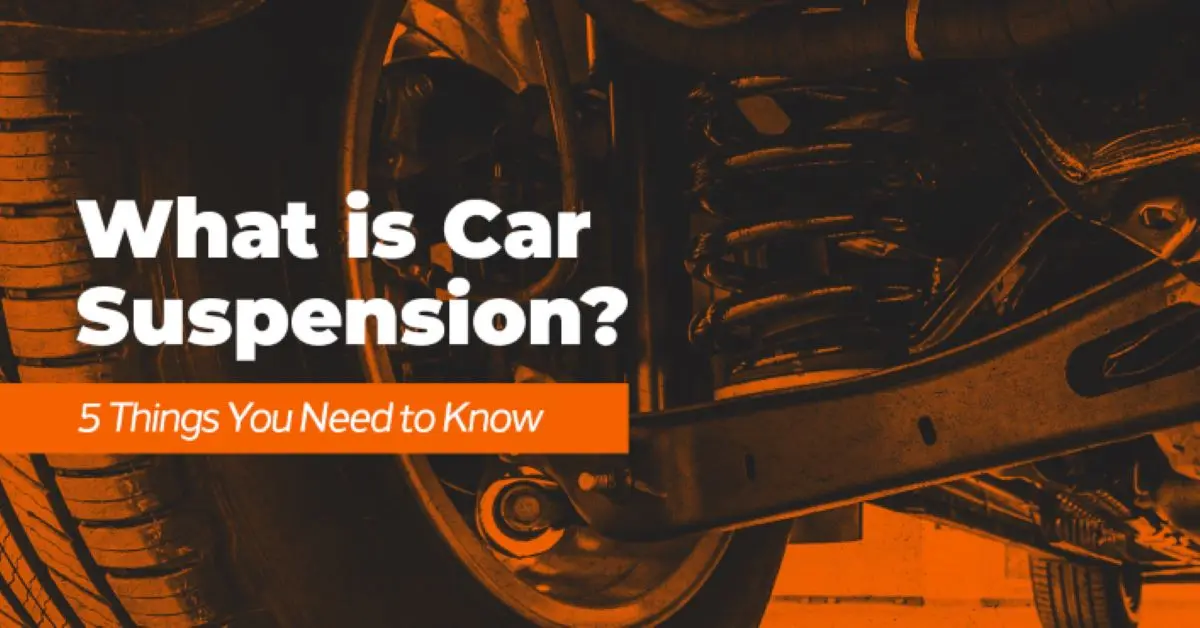Your car’s suspension system smooths out bumps in the road and provides traction by keeping the wheels on the ground.
In short, the suspension system has a big role to play in keeping you safe – even whilst travelling at high speeds.
Read on and find out how your car’s suspension system works, how to know when yours needs replacing, and more.
Page Contents
What Is the Suspension on a Car?
Your car’s suspension system ensures you enjoy a comfortable driving experience and road stability when everything is working well.
The suspension system connects the vehicle to its wheels, allowing motion between the two.
It absorbs energy transferred through your car’s wheels and helps your car ride smoothly – even on uneven terrain.
The suspension system helps support the weight of your car, prevents excessive bouncing, and helps maintain optimal tyre contact with the road.
A working suspension system allows you to drive safely at high speeds, which is why it’s important to have any issues fixed right away.
For instance, track rod end issues can cause problems with your suspension.
How Does a Car's Suspension Work?
Watch our video below to see how the suspension in your car works.
There are 7 main suspension parts that make up a car's suspension system:
- Springs
- Shock absorbers
- Struts
- Anti-roll bars
- Anti-roll bar link rods
- Bottom suspension arm
- Top strut mount
Springs
The most common spring found on modern cars and light vans is the coil spring, but you can find leaf springs.
The springs coil and uncoil to absorb the motion of the wheels.
Engineers often talk about the sprung and unsprung mass of a car, due to where the springs are fitted.
Sprung mass is the vehicle’s mass supported on the springs.
Unsprung mass is the mass supported between the road and the springs.
Shock Absorbers
Without shock absorbers, springs alone can’t provide the smoothest ride.
Shock absorbers control unwanted spring motion through dampening.
They sit between the frame of the car and the wheels, absorbing the energy from the springs.
A shock absorber contains hydraulic fluid and acts like an oil pump.
This fluid slows down the movement of the shock absorber, in turn slowing down the movement of the spring.
If your suspension is creaking, then you may need to book a shock absorber replacement.
Other warning signs include wavy tyre tread, your car bouncing more than usual when driving over bumps, or your stopping distance being up to 20% further than usual.
Struts
Shocks and struts are similar components, but they serve different purposes.
Most cars use a MacPherson suspension system.
In this design, coil springs and shock absorbers are fitted together and known as a strut.
Struts dampen the spring’s bounciness and provide more structural support for the suspension than shock absorbers do.
They are fitted to the front of the car and the top is connected to the body and the bottom to a suspension arm.
Anti-roll Bars
Anti-roll bars give the vehicle extra stability.
They are metal rods that span the entire axle and join the sides of the suspension together.
When one side moves up and down, the anti-roll bar transfers movement to the other wheel.
This creates a more level ride and makes for smooth cornering.
Anti-roll Bar Link Rods
Link rods connect the suspension parts to either end of the anti-roll bar.
They are usually light metal or plastic rods with a ball joint on one of both ends.
Link rods help your car when one side of the suspension moves but the other does not.
Bottom Suspension Arm
The bottom suspension arm is one of two control arms in the front suspension system.
It connects the car’s frame to the front wheel assembly and holds the front wheels on the road.
These arms can swing up and down as the wheels roll over bumps, allowing your car to move smoothly.
Top Strut Mount
The top strut mount attaches the struts to the vehicle.
It also insulates against tyre noise and vehicle vibrations.
Are Front and Rear Suspension Different?
Yes, front and rear suspension are different.
Front Suspension
Most modern cars are front-wheel drive, and need flexible, responsive front suspension to work well.
This is known as independent suspension, which allows each wheel on the same axle to move on its own.
Rear Suspension
Rear suspension doesn’t need to accommodate a steering system.
This means they are usually dependent suspension systems.
These have a rigid axle connecting the wheels, which is kept in place by leaf springs and shock absorbers.
If independent suspension is also used at the rear, the vehicle will have four-wheel drive.
While cars can use the same suspension system at the front and the rear, most vehicles use a mix of dependent and independent.
Independent suspension is more expensive to produce and more important to have at the front of the car than the rear.
How Do You Inspect Car Suspension?
Watch our video to see how you can inspect your car’s suspension using the bounce test.
The bounce test involves pressing down on your car’s bonnet and releasing the weight to see how many times the car bounces.
If it’s more than a couple times, there is probably a suspension problem needing fixed.
How Long Does the Suspension Last on a Car?
Your car’s suspension can last anywhere from 50,000 to 100,000 miles before you need to replace any parts.
This can depend on your driving habits and commitment to vehicle maintenance.
Shock absorbers should be replaced every 50,000 miles or 5 years.
What Does a Suspension Problem Feel Like?
A suspension problem can feel like experiencing a bumpier ride than usual.
The car may also feel lower on one side than the other.
Poor handling and abnormal tyre tread wear can also suggest that you have a suspension problem.
If your car suspension is bad, then you’ll find it difficult to steer, the steering wheel might vibrate, and you may notice an increase in braking distance.
Can You Drive with a Broken Suspension?
No, you shouldn’t drive a car with a broken suspension.
You should have any worn suspension parts repaired or replaced before you drive again.
Continuing to drive with a damaged suspension part could cause long-term damage to your vehicle.
Not to mention that you could lose control of your car.
How Do I Know If My Suspension Needs Replacing?
The suspension may have gone on your car if you notice your car drifts or pulls when you turn corners.
You may hear a knocking sound at the same time.
A damaged anti-roll bar could be to blame, as it won’t be keeping the car stable against the force of the turn.
You should have your suspension checked out right away to avoid any serious safety risks.
Any number of parts could be in need of repair or replacement, so make sure you consult a professional mechanic if you think your suspension if failing.








No comments yet
Leave a comment